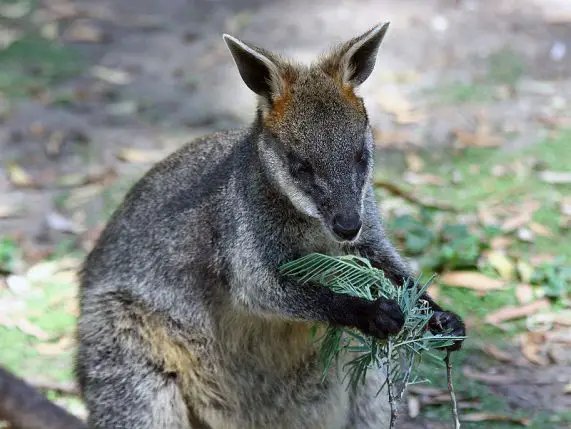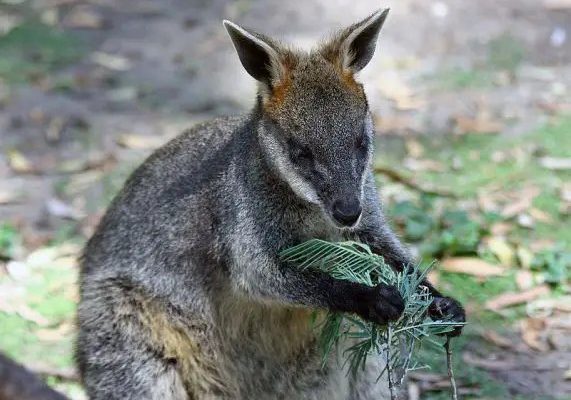
So, what do swamp wallabies eat, and how do they manage to find their food? Let’s break down their diet and hunting techniques, much like peeling back the layers of an onion, revealing just how resourceful these animals really are.
What Do Swamp Wallabies Eat?
Swamp wallabies are primarily herbivores, which means they thrive on a plant-based diet. Their choices reflect their habitat, which largely consists of grasslands, woodlands, and wetlands. Picture a cozy dining room filled with the freshest ingredients—this is how they approach their meals. They prefer to munch on a variety of plants, focusing on:
- Grasses: Their staple food source, especially in the warmer months.
- Leaves and shrubs: They nibble on various leaves, savoring the tender ones that are easy to digest.
- Fruits and flowers: In the right season, they’ll treat themselves to these sweet natural snacks.
By foraging through their environment, swamp wallabies ensure they get a diverse array of nutrients. This is crucial for their overall health and vitality, especially if they need to fend off predators or thrive during the winter months when food is scarce.
How Swamp Wallabies foraged
When you think of the swamp wallaby’s hunting strategies—it’s a bit of a misnomer. They don’t hunt in the traditional sense; rather, they forage for food. This means they search for and gather food rather than staging a chase. Their foraging behavior is quite strategic. Here’s how they do it:
First, swamp wallabies often feed during the cooler parts of the day, like early morning or late afternoon. This approach helps them avoid the heat of midday when food might be harder to find, and moving around can be exhausting. Imagine going grocery shopping in the cool, crisp morning air versus the blazing afternoon sun.
Next, they’re quite selective eaters. Swamp wallabies will taste different plants to determine which are the tastiest and most nutritious. They tend to prefer young, tender shoots over older, tougher ones. This selective feeding not only maximizes their nutrient intake but also supports the plant life in their habitat by allowing older plants to continue growing.
Adaptations in Feeding Behavior
Swamp wallabies have developed specific adaptations that enhance their foraging success. For instance, they possess strong, muscular hind legs that allow them to hop quickly and cover large distances in search of food. This agility is crucial when they need to evade potential threats, like foxes or eagles.
Additionally, their stomachs are designed to efficiently digest tough plant material. They have a complex digestive system that ferments food in a special pouch-like stomach, similar to how cows digest grass. This means they can extract maximum nutrients from their plant-based meals, making them well-suited for the dietary demands of their environment.
Seasonal Diet Changes
Just like how we adjust our meals based on the season—think of cozy soups in winter versus refreshing salads in summer—swamp wallabies adjust their diets throughout the year.
In autumn and winter, their diet shifts toward more fibrous plant materials. During these colder months, they often turn to bark, tough leaves, and other hard-to-chew vegetation. This is their way of adapting to the limited availability of fresh greens. You might even say they’re winterizing their meals, ensuring that they have enough nutrition to get through the cold.
In spring and summer, however, they have access to a bounty of delicious grasses and tender shoots. During this time, they fill their plates—so to speak—with fresh foliage and flowering plants. This seasonal cycle not only affects what they eat but also their overall health and energy levels.
The Role of Swamp Wallabies in Their Ecosystem
The hunting strategies and dietary habits of swamp wallabies play a significant role in maintaining their ecosystem. When they graze on grasses and other vegetation, they help promote plant growth by preventing certain species from dominating the landscape. Their foraging habits create a healthy balance in their habitat.
Moreover, by eating fruits and dispersing the seeds through their droppings, they contribute to plant propagation. This means that swamp wallabies are not just passive eaters; they actively shape their environment, ensuring that both they and future generations of animals can thrive.
Threats and Conservation
While swamp wallabies are resourceful, they face several threats that impact their survival. Habitat loss due to urban development and agriculture is a major concern. As wetlands are drained or cleared, these animals lose their essential foraging grounds.
Additionally, predation by introduced species like dogs and foxes can significantly reduce swamp wallaby populations. Conservation efforts are crucial to preserving their natural habitats and ensuring they have the resources they need to survive.
Initiatives such as habitat restoration and wildlife corridors can help mitigate these threats, allowing swamp wallabies to continue their important role in the ecosystem.
The swamp wallaby is a remarkable creature, demonstrating the intricate balance of nature through its unique diet and foraging strategies. By understanding how these marsupials eat and thrive, we can appreciate not just their role in the ecosystem but also the importance of conserving their habitats.
Next time you think about wildlife in Australia, remember the swamp wallaby—not just for its charm but for its clever adaptations and the essential role it plays in its environment. By advocating for their protection, we ensure that future generations will be able to witness the beauty and uniqueness of these fascinating creatures.

